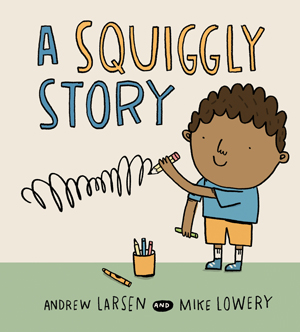| ________________
CM . . .
. Volume XXIII Number 19. . . .January 27, 2017
excerpt:
A Squiggly Story is a book that encourages young people to write. Andrew Larsen and Mike Lowery convey a message of hope to budding young writers. In their minds at least, anyone can write, and the meaning of the message is far more important than the form of the message. The young story protagonist admires his big sister and her ease with reading and writing. He, however, struggles until his supportive sister frees him of some of his inhibitions. There is much to like about the messages of this book. A Squiggly Story depicts a positive sibling relationship. The older sister inspires her brother. Similarly, the unnamed protagonist’s teacher and classmates react favourably to the boy’s imperfect, incomplete story attempt. This conveys the appropriate message to young writers that one can tell a story even if he or she does not know how to write all the words. Although we like the message contained in Larsen’s written text, neither of us were enamoured with Lowery’s illustrations. Voice balloons and comic strip-styled panels will appeal because of young readers’ enjoyment of comics and graphic novels, and the Photoshopped artwork is colourful. Yet we still found it flat, stagnant, unattractive, and lacking movement and fluidity. It is obviously intended to reflect the drawings of a young child, but we feel the book would be stronger with better illustrations. Several aspects of the overall design and presentation are problematic. The different text fonts are occasionally distracting. The mix of voice balloons and paragraphed narrative might be confusing. There is inconsistency in the design that interferes with the overall flow of the book. Double-page-spread-sized illustrations follow pages in which several small comic panels appear, each containing their own illustrations. The end result is a busy, sometimes discombobulating, choppy book design. Within this book, teachers will see elements reflective of guided writing instruction. Indeed, some teachers will likely choose to employ the book as a model for guided instruction. We feel, however, that Peter Reynolds’ books The Dot and ish are both stronger books that express the same messages. We concede that some of our criticism of the artwork is simply a matter of stylistic preference. Neither of us particularly likes the artwork, but we feel that it is more than just a matter of taste. We think that the illustrations detract from the positive message of A Squiggly Story. Recommended With Reservations. Dr. Gregory Bryan is a member of the Faculty of Education at the University of Manitoba in Winnipeg, MB. He specializes in children’s literature.
To comment
on this title or this review, send mail to cm@umanitoba.ca.
Copyright © the Manitoba Library Association. Reproduction for personal
use is permitted only if this copyright notice is maintained. Any
other reproduction is prohibited without permission.
Next Review | Table of Contents For This Issue - January 27, 2017 |
